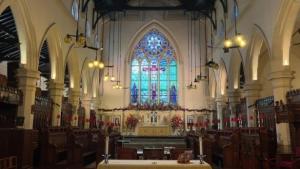HONG KONG, CHINA, March 21, 2024 /EINPresswire.com/ — Historical buildings contain stories of the past, cultural characteristics, and artistic styles, offering a glimpse into the historical development and the way people lived. These buildings have cultural, economic, landscape, and social value, necessitating well preservation. Dr. Jiaying Zhang, who taken her master’s studies in sustainable heritage at University College London from 2016. Subsequently, she conducted research in the field of architecture and engineering intelligence at Tsinghua University and Hong Kong University of Science and Technology. She has been devoted to the study of in-depth theories, policies and advanced methods of the preservation of historical buildings. Her research activities span across various climatic zones, including mainland China, Hong Kong SAR, London, and Malta. Dr. Zhang’s team has created digital twins of historical buildings that not only support the preservation of their current state but also provide accurate databases for the future renovation and emergency management of these buildings.
Historic buildings are characterized by complex morphology and have often undergone changes over different eras, such as function transformation, and shifts in technology and regulation, often lack clear and traceable construction records. Dr. Zhang’s team proposed a solution to the lack of information by integrating documents, data, and graphics into the information model for heritage building preservation (Heritage Building Information Modelling-HBIM). The team also improved HBIM modeling methods for buildings with regular and irregular geometries, supporting Computational Fluid Dynamics (CFD) simulations for the preservation of historical buildings. Moreover, team members Zhenyu Liang and Jeff Chak Fu Chan have efficiently reconstructed three-dimensional models of historical buildings with high precision based on the 3D Gaussian Splatting (3DGS) technique, accurately restoring real scenes of historical buildings and developing lightweight models for complex buildings, facilitating the rapid establishment of virtual tour experiences.
Historical buildings are faced with the significant challenge of air quality management. One of the examples was “FWD HOUSE 1881” in the heart of Tsim Sha Tsui, Hong Kong SAR, a declared monument, was renovated from the former Hong Kong Marine Police Headquarters into a cultural and commercial landmark. Exposed to surrounding seawater and poor environmental conditions, signs of oxidation, discoloration, and aging in wood are evident. To optimize the HVAC system for improving the environment and thus protect the historical buildings and their stored collections, Dr. Zhang’s team (Jiaying Zhang, CHAN Chi Chun, KWOK Helen Hoi Ling) utilized advanced technologies including HBIM integration with Geographic Information System (GIS), Virtual Reality/ Augmented Reality (VR/AR), Information and Internet of Things (IoT), CFD simulation, Artificial Intelligence (AI) and data analytics forecasting, as well as energy consumption simulations to create a digital twin of FWD HOUSE 1881. An interactive platform based on the digital twin has been developed for historical building protection by HBIM, AR, IoT, and AI technology. This digital twin aims to enhance environmental management for the protection of historical buildings and their collections.
This research achieved: (1) Integration of HBIM and GIS to support CFD simulations of the fluid dynamics around historical buildings; (2) The fusion of IoT and HBIM to visualize environmental data at different locations within historical buildings; (3) CFD simulation analysis based on HBIM to study the impact of air conditioning equipment settings and layouts under different conditions to improve building heritage protection and personnel health; (4) Combining HBIM with Autodesk Insight and OpenStudio for energy simulation to improve the accuracy and timeliness of air conditioning system controls, saving energy and reducing carbon emissions to support sustainable commercial operation of historical buildings, with potential energy savings up to 30%; and (5) Using AI technology to predict changes in environmental parameters, allowing for adjustments to the HVAC system in advance, thereby addressing the delay in cooling, heating, and air exchange to protect historical buildings from damage.
The outcomes have been published in SCI top-tier journals, including the internationally recognized journal in building environment, Building and Environment (Top, IF:7.4). The project received the 2022 Building Information Modelling (BIM) Achievement Award from the Hong Kong Construction Industry Council and the Hong Kong Development Bureau, and the 2023 Autodesk Hong Kong Building Information Modelling (BIM) Outstanding Student Award.
Published research articles and references:
Jiaying Zhang, Helen H.L. Kwok, Han Luo, Jimmy C.K. Tong, Jack C.P. Cheng*. (2022). Automatic relative humidity optimization in underground heritage sites through ventilation system based on digital twins. Building and Environment, 216, 108999. (Top, IF:7.4)
Jiaying Zhang, Chevy C.C. Chan, Helen H.L. Kwok, Jack C.P. Cheng*. (2023). Multi-indicator adaptive HVAC control system for low-energy indoor air quality management of heritage building preservation. Building and Environment, 246, 110910. (Top, IF:7.4)
Jiaying Zhang, Kwok Ho Poon, Helen H.L. Kwok, Fangli Hou, Jack C.P. Cheng*. (2023). Predictive control of HVAC by multiple output GRU-CFD integration approach to manage multiple IAQ for commercial heritage building preservation. Building and Environment, 245, 110802. (Top, IF:7.4)
Jack CP Cheng; Jiaying Zhang*; Helen HL Kwok; Jimmy CK Tong, (2024). Thermal performance improvement for residential heritage building preservation based on digital twins, Journal of Building Engineering 2023: 108283. (Top, IF:6.4)
Jennifer Jiaying ZHANG
The Hong Kong University of Science and Technology
email us here
